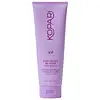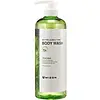What's inside
What's inside
 Key Ingredients
Key Ingredients

No key ingredients
 Benefits
Benefits

 Concerns
Concerns

 Ingredients Side-by-side
Ingredients Side-by-side

Water
Skin ConditioningPumice
AbrasiveGlycerin
HumectantLactic Acid
BufferingGlycolic Acid
BufferingCaprylic/Capric Triglyceride
MaskingHydroxypropyl Starch Phosphate
Stearic Acid
CleansingCetearyl Alcohol
EmollientSorbitan Oleate Decylglucoside Crosspolymer
CleansingSodium Lauroyl Sarcosinate
CleansingSodium Hydroxide
BufferingCocos Nucifera Shell Powder
AbrasiveVolcanic Sand
Skin ConditioningAvena Sativa Kernel Extract
AbrasiveSalix Nigra Bark Extract
Skin ProtectingCamellia Sinensis Leaf Extract
AntimicrobialSimmondsia Chinensis Seed Oil
EmollientLactobacillus Ferment
Skin ConditioningGlycyrrhiza Glabra Root Extract
BleachingSorbitol
HumectantDecyl Glucoside
CleansingHydroxyethylcellulose
Emulsion StabilisingLauryl Glucoside
CleansingGlyceryl Stearate
EmollientSodium Methyl Cocoyl Taurate
CleansingSodium Stearoyl Lactylate
EmulsifyingPotassium Sorbate
PreservativeSodium Benzoate
MaskingPhenoxyethanol
PreservativeWater, Pumice, Glycerin, Lactic Acid, Glycolic Acid, Caprylic/Capric Triglyceride, Hydroxypropyl Starch Phosphate, Stearic Acid, Cetearyl Alcohol, Sorbitan Oleate Decylglucoside Crosspolymer, Sodium Lauroyl Sarcosinate, Sodium Hydroxide, Cocos Nucifera Shell Powder, Volcanic Sand, Avena Sativa Kernel Extract, Salix Nigra Bark Extract, Camellia Sinensis Leaf Extract, Simmondsia Chinensis Seed Oil, Lactobacillus Ferment, Glycyrrhiza Glabra Root Extract, Sorbitol, Decyl Glucoside, Hydroxyethylcellulose, Lauryl Glucoside, Glyceryl Stearate, Sodium Methyl Cocoyl Taurate, Sodium Stearoyl Lactylate, Potassium Sorbate, Sodium Benzoate, Phenoxyethanol
Water
Skin ConditioningSodium Laureth Sulfate
CleansingAmmonium Lauryl Sulfate
CleansingCocamidopropyl Betaine
CleansingCocamide Mea
EmulsifyingButylene Glycol
HumectantMelaleuca Alternifolia Leaf Extract
PerfumingRose Extract
Skin ConditioningLavandula Angustifolia Extract
Skin ConditioningCalendula Officinalis Extract
Skin ConditioningBombyx Mori Extract
Skin ConditioningZanthoxylum Piperitum Fruit Extract
Skin ConditioningHydrolyzed Sesame Extract
Skin ConditioningTurtle Extract
EmollientBarm Extract
Skin ConditioningGlycine Soja Extract
Skin ConditioningEel Extract
HumectantRibes Nigrum Seed Extract
EmollientOryza Sativa Extract
AbsorbentLimus Extract
Skin ConditioningGlycerin
HumectantSodium Chloride
MaskingCitric Acid
BufferingPolyquaternium-10
Coconut Acid
CleansingPhenoxyethanol
PreservativeDisodium EDTA
1,2-Hexanediol
Skin ConditioningLauryl Alcohol
EmollientAmmonium Sulfate
Sodium Benzoate
MaskingLaureth-2
CleansingSodium Sulfate
Aroma
Linalool
PerfumingWater, Sodium Laureth Sulfate, Ammonium Lauryl Sulfate, Cocamidopropyl Betaine, Cocamide Mea, Butylene Glycol, Melaleuca Alternifolia Leaf Extract, Rose Extract, Lavandula Angustifolia Extract, Calendula Officinalis Extract, Bombyx Mori Extract, Zanthoxylum Piperitum Fruit Extract, Hydrolyzed Sesame Extract, Turtle Extract, Barm Extract, Glycine Soja Extract, Eel Extract, Ribes Nigrum Seed Extract, Oryza Sativa Extract, Limus Extract, Glycerin, Sodium Chloride, Citric Acid, Polyquaternium-10, Coconut Acid, Phenoxyethanol, Disodium EDTA, 1,2-Hexanediol, Lauryl Alcohol, Ammonium Sulfate, Sodium Benzoate, Laureth-2, Sodium Sulfate, Aroma, Linalool
 Reviews
Reviews

Ingredients Explained
These ingredients are found in both products.
Ingredients higher up in an ingredient list are typically present in a larger amount.
Glycerin is already naturally found in your skin. It helps moisturize and protect your skin.
A study from 2016 found glycerin to be more effective as a humectant than AHAs and hyaluronic acid.
As a humectant, it helps the skin stay hydrated by pulling moisture to your skin. The low molecular weight of glycerin allows it to pull moisture into the deeper layers of your skin.
Hydrated skin improves your skin barrier; Your skin barrier helps protect against irritants and bacteria.
Glycerin has also been found to have antimicrobial and antiviral properties. Due to these properties, glycerin is often used in wound and burn treatments.
In cosmetics, glycerin is usually derived from plants such as soybean or palm. However, it can also be sourced from animals, such as tallow or animal fat.
This ingredient is organic, colorless, odorless, and non-toxic.
Glycerin is the name for this ingredient in American English. British English uses Glycerol/Glycerine.
Learn more about GlycerinPhenoxyethanol is a preservative that has germicide, antimicrobial, and aromatic properties. Studies show that phenoxyethanol can prevent microbial growth. By itself, it has a scent that is similar to that of a rose.
It's often used in formulations along with Caprylyl Glycol to preserve the shelf life of products.
Sodium Benzoate is a preservative. It's used in both cosmetic and food products to inhibit the growth of mold and bacteria. It is typically produced synthetically.
Both the US FDA and EU Health Committee have approved the use of sodium benzoate. In the US, levels of 0.1% (of the total product) are allowed.
Sodium benzoate works as a preservative by inhibiting the growth of bacteria inside of cells. It prevents the cell from fermenting a type of sugar using an enzyme called phosphofructokinase.
It is the salt of benzoic acid. Foods containing sodium benzoate include soda, salad dressings, condiments, fruit juices, wines, and snack foods.
Studies for using ascorbic acid and sodium benzoate in cosmetics are lacking, especially in skincare routines with multiple steps.
We always recommend speaking with a professional, such as a dermatologist, if you have any concerns.
Learn more about Sodium BenzoateWater. It's the most common cosmetic ingredient of all. You'll usually see it at the top of ingredient lists, meaning that it makes up the largest part of the product.
So why is it so popular? Water most often acts as a solvent - this means that it helps dissolve other ingredients into the formulation.
You'll also recognize water as that liquid we all need to stay alive. If you see this, drink a glass of water. Stay hydrated!
Learn more about Water